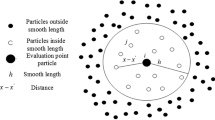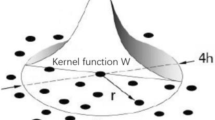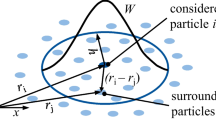Abstract
In order to study the mechanism of crack propagation, the varied cutting-depth scratch experiment is carried out and smoothed particle hydrodynamics (SPH) simulation method is used to assistant the investigation. The SPH simulation results reveal that crack will propagate in the direction where stress concentration exceeds the fracture toughness of K9 glass. The initial crack length in critical transition depth is calculated by combining the critical stress of fracture and the fracture toughness of K9 glass. Based on the effective plastic strain, the relation between scratching depth and crack depth is obtained. The recovery of crack tip is found and explained from the relationship between cutting depth and crack depth. Using the energy balance theory of Griffith, the variation of material internal energy is revealed. Comparing the scratching forces obtained from experiment and simulation, the validity of simulation results is verified. The phenomenon of crack delayed propagation is found in both experiment and simulation. The explanation of mechanism is given.
















Similar content being viewed by others
References
Peirrat, C., Siegrist, T., Marco, J. D., et al. (1996). Multiple-layer blank structure for phase-shifting mask fabrication. Journal of Vacuum Science & Technology B, 14, 63.
Bifano, T. G., Dow, T. A., & Scattergood, R. O. (1991). Ductile-regime grinding: A new technology for machining brittle materials. Journal of Engineering for Industry-Transactions of the ASME, 113(2), 184–189.
Leng, B. (2015). Research on grinding subsurface crack and depth prediction of optical glass. Harbin: Harbin Institute of Technology.
Zhang, F. H., Li, C., & Zhao, H. (2016). Prediction model and experimental study of subsurface damage depths in grinding for K9 glasses. China Mechanical Engineering, 27(18), 2442–2446.
Zhang, F. H., Li, C., & Meng, B. (2016). Investigation of surface deformation characteristic and removal mechanism for K9 glass based on varied cutting-depth nano-scratch. Journal of Mechanical Engineering, 52(17), 65–71.
Wang, J., Zhang, C., Feng, P., & Zhang, J. (2016). A model for prediction of subsurface damage in rotary ultrasonic face milling of optical K9 glass. International Journal of Advanced Manufacturing Technology, 83(1-4), 347–355.
Guo, X., Wei, Y., Jin, Z., & Guo, D. (2013). A numerical model for optical glass cutting based on SPH method. International Journal of Advanced Manufacturing Technology, 68, 1277–1283.
Su, C., Zhang, Y., Hou, J., & Wang, W. (2008). Numerical simulation and analysis for metal cutting processes based on FEM and SPH[P]. System Simulation and Scientific Computing, 2008. ICSC 2008. Asia Simulation Conference - 7th International Conference on, 2008.
Mir, A., Luo, X., & Sun, J. (2016). The investigation of influence of tool wear on ductile to brittle transition in single point diamond turning of silicon. Wear, 364–365, 233–243.
Xiaoguang, G., Ziyuan, L., Hang, G., et al. (2015). Simulation research of nanoindentation on the (001) face of KDP crystal. Journal of Synthetic Crystals, 05, 1149–1155.
Lucy, L. B. (1977). A numerical approach to the testing of fusion processes. The Astronomical, 82, 1013–1024.
Ning, J., & Liang, S. Y. (2018). Model-driven determination of Johnson–Cook material constants using temperature and force measurements. The International Journal of Advanced Manufacturing Technology, 97, 1053–1060.
Tugrul, O., & Yigit, K. (2007). Identification of constitutive material model parameters for high-strain rate metal cutting conditions using evolutionary computational algorithms. Materials and Manufacturing Processes, 22, 659–667.
Li, Q., Xu, Y. B., & Bassim, M. N. (2004). Dynamic mechanical behavior of pure titanium. Journal of Materials Processing Technology, 155–156, 1889–1892.
Ning, J., Nguyen, V., et al. (2018). Inverse determination of Johnson–Cook model constants of ultra-fine-grained titanium based on chip formation model and iterative gradient search. The International Journal of Advanced Manufacturing Technology., 99, 1131–1140.
Ning, J., & Liang, S. Y. (2019). A comparative study of analytical thermal models to predict the orthogonal cutting temperature of AISI 1045 steel. The International Journal of Advanced Manufacturing Technology, 100, 1–11.
Johnson, G. R., & Holmquist, T. J. (1994). An improved computational constitutive model for brittle materials (pp. 981–984). Colorado Springs: High-Pressure Science and Technology.
Ning, J., & Liang, S. Y. (2018). Prediction of temperature distribution in orthogonal machining based on the mechanics of the cutting process using a cinstitutive model. Journal of Manufracturing and Materials Processing, 2, 37.
Chengyu, W. (2007). Handbook of glass materials (pp. 535–555). Beijing: Chemical Industrial Press.
Yao, P., Yoshihara, N., & Hitomi, N. (2010). Ductile and brittle mode grinding of fused silica. Key Engineering Materials, 447–448, 21–25.
Lee, S. H. (2012). Analysis of ductile mode and brittle transition of AFM nanomachining of silicon. International Journal of Machine Tools & Manufacture, 61, 71–79.
Lawn, B. R., & Wilshaw, T. R. (1985). Fracture of brittle solids (pp. 9–11). Beijing: Earthquake Press.
Griffith, A. A. (1924). Theory of rupture. In C. B. Bjezeno & J. M. Burgers (Eds.), Proceedings of the first international congress for applied mechanics (p. 55). Delft: J. Waltman Jr.
Obreimoff, J. W. (1930). The splitting strength of mica. Proceedings of the Royal Society of London A, 127, 290.
Larnbropoulos, J. C., & Jacobs, S. D. (1999). Material removal mechanisms from grinding to polishing. Ceramic Transactions, 102, 113–128.
Wang, Z., Wu, Y. L., & Dai, Y. (2008). Rapid detection of subsurface damage of optical materials in lapping process and its influence regularity. Optics and Precision Engineering, 1, 16–21.
Lawn, B. R., & Evans, A. G. (1977). A model for crack initiation in elastic/plastic indentation fields. Journal of Materials Science, 12(11), 2195–2199.
Acknowledgements
The authors would like to acknowledge the financial support from the National Natural Science foundation of China (General Program, Nos. 51575083 and 51505063), Science Fund for Creative Research Groups (No. 51621064) and the EPSRC (EP/K018345/1) in the UK.
Author information
Authors and Affiliations
Corresponding authors
Additional information
Publisher's Note
Springer Nature remains neutral with regard to jurisdictional claims in published maps and institutional affiliations.
Rights and permissions
About this article
Cite this article
Guo, X., Shi, Y., Luo, X. et al. Mechanism of Crack Propagation for K9 Glass. Int. J. Precis. Eng. Manuf. 20, 815–825 (2019). https://doi.org/10.1007/s12541-019-00109-w
Received:
Revised:
Accepted:
Published:
Issue Date:
DOI: https://doi.org/10.1007/s12541-019-00109-w




